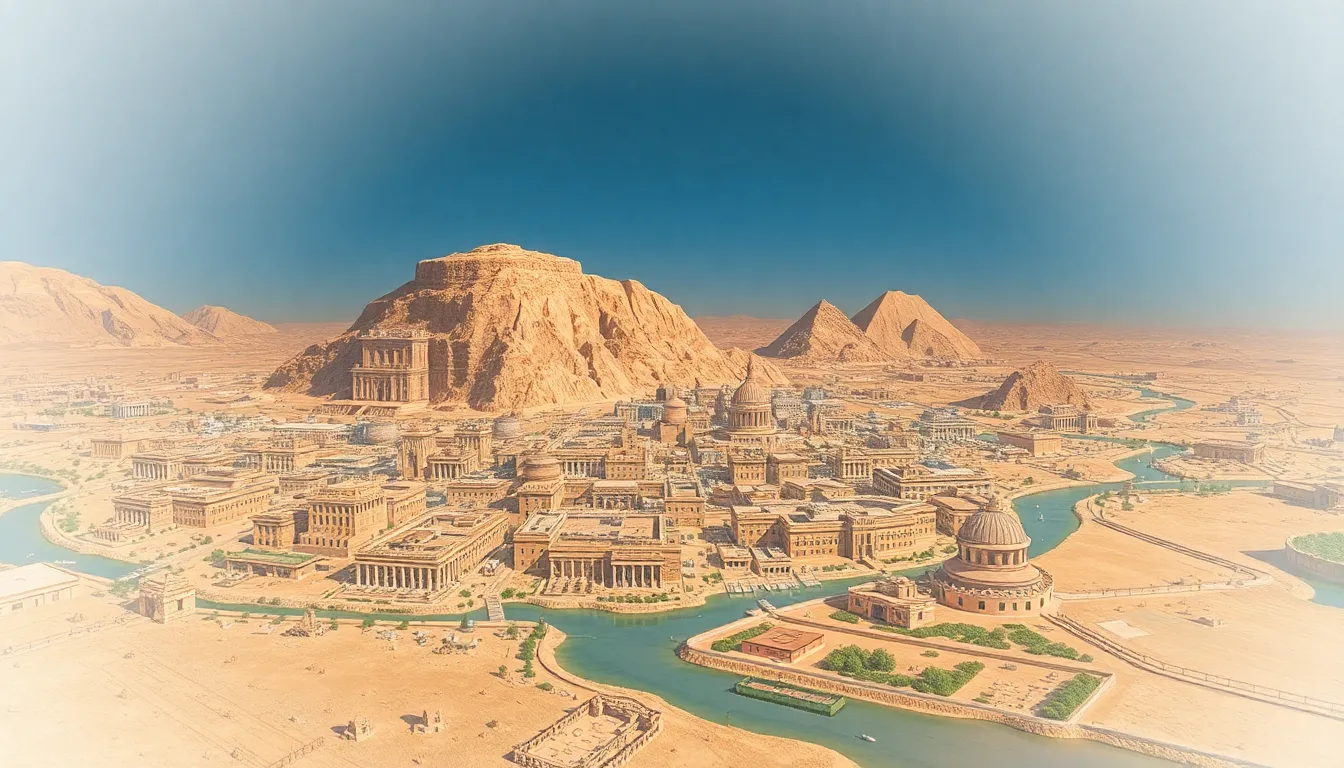The Mythical Geography of the City of Koptos
I. Introduction
Koptos, known today as Qift, was an ancient city in Egypt that played a crucial role in the civilization’s history and mythology. Situated near the Nile River, Koptos served as a significant religious and commercial hub, linking Upper Egypt with the Red Sea. Its historical significance is matched by its rich tapestry of myths and legends that shaped the cultural identity of ancient Egyptians.
The concept of mythical geography in ancient cultures refers to the ways in which geographical locations are imbued with cultural, spiritual, and narrative significance. In the case of Koptos, its topography and landmarks were intertwined with the myths of creation, divine beings, and the afterlife, contributing to a deeper understanding of the ancient Egyptian worldview.
This article seeks to explore the mythical geography of Koptos, examining its historical context, role in mythology, geographical features, and its legacy in both ancient and modern times.
II. Historical Context of Koptos
Koptos was founded around 3000 BCE and quickly became a pivotal city in ancient Egypt. As a center for trade and religious worship, it thrived under various dynasties.
In the context of ancient Egyptian civilization, Koptos was closely associated with the worship of the god Amun and served as a gateway for expeditions to the gold mines of the Eastern Desert. The city was known for its temples and monumental architecture, which reflected the grandeur of Egyptian civilization.
Key archaeological findings in Koptos include:
- Ruins of temples dedicated to Amun and other deities.
- Artifacts such as pottery, jewelry, and inscriptions that provide insight into daily life and religious practices.
- Graves and burial sites that illuminate the customs surrounding death and the afterlife.
III. Koptos in Ancient Egyptian Mythology
Koptos played a significant role in several Egyptian creation myths. It was believed to be a site where the primordial waters met, giving rise to the first land and the beginning of creation. The city’s name itself is often associated with the concept of opening or opening the way, symbolizing the emergence of life from chaos.
Koptos was closely linked to various deities, particularly Amun, who was worshipped as the king of the gods. Religious practices in Koptos often included elaborate rituals and festivals that honored these deities. The myths surrounding Koptos often reflected themes of rebirth, fertility, and the cyclical nature of life.
Some notable myths include:
- The story of the creation of the world from the waters of chaos, with Koptos as a central location.
- Legends of divine interventions and miracles performed by deities associated with the city.
- Myths about the afterlife and the journey of the soul, emphasizing Koptos’ role as a spiritual waypoint.
IV. The Geographical Landscape of Koptos
The geographical landscape of Koptos is marked by its proximity to the Nile River, which has had a profound impact on its identity. The Nile not only provided sustenance and trade routes but also served as a symbol of life and resurrection in Egyptian mythology.
Natural features in and around Koptos were often interpreted through a mythical lens, with mountains and valleys seen as manifestations of divine presence. The sacred sites, including temples and shrines, were strategically placed to align with these features, reinforcing their spiritual significance.
Key geographical elements include:
- The Nile River, viewed as the lifeblood of Egypt and a source of fertility.
- The surrounding deserts, which were often seen as the realm of the dead and the unknown.
- Sacred mountains that were believed to be the abodes of the gods.
V. Symbolism and Representations of Koptos
Koptos has been depicted in various artistic forms throughout ancient Egyptian history. Temples, wall reliefs, and pottery often illustrate its significance, showcasing the city’s connection to the divine.
The symbolism attached to Koptos’ geography includes:
- The Nile as a symbol of life, death, and rebirth.
- The desert as a boundary between the living and the dead.
- Mountains as symbols of divine presence and stability.
Koptos was portrayed in literature and folklore as a thriving city blessed by the gods, emphasizing its cultural importance and mythical status.
VI. Koptos in Modern Scholarship
Recent archaeological discoveries have shed new light on Koptos, revealing the extent of its influence in ancient Egypt. Excavations have uncovered new temples, inscriptions, and artifacts that contribute to a more nuanced understanding of the city’s role in history.
Modern interpretations of Koptos’ mythical geography highlight its significance in the broader context of Egyptian studies. Scholars are increasingly recognizing the interplay between geography, mythology, and cultural identity in understanding ancient cities.
VII. The Legacy of Koptos
The influence of Koptos extends beyond ancient times, shaping later cultures and cities in Egypt and beyond. Its rich history and mythical geography continue to captivate scholars and enthusiasts alike.
The preservation of Koptos’ mythical geography is vital for cultural heritage, with ongoing efforts to protect archaeological sites and educate the public about their significance. Koptos also plays a role in tourism, drawing visitors interested in exploring ancient Egyptian culture and mythology.
VIII. Conclusion
In recap, Koptos stands out as a beacon of ancient Egyptian mythical geography, embodying the intersection of history, myth, and spirituality. Understanding Koptos through a mythical lens offers profound insight into the values and beliefs of ancient Egyptians.
As research continues, the importance of Koptos in the study of ancient civilizations remains significant. Future directions may explore deeper connections between Koptos and other ancient sites, contributing to a richer understanding of the mythical geography that shaped human history.




